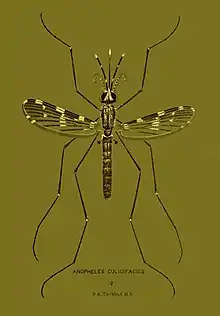Anopheles culicifacies
Anopheles culicifacies is a mosquito species complex and one of the major vectors of malaria on the Indian subcontinent.[1] It consists of five sibling species, provisionally designated as species A, B, C, D, and E.[2] It prefers to rest indoors in cattle sheds, where it feeds on cattle. The control of A. culicifacies has become difficult due to development of insecticide resistance against all commonly used insecticides, including new-generation insecticides such as synthetic pyrethroids.[3]
| Anopheles culicifacies | |
|---|---|
 | |
| Scientific classification | |
| Domain: | Eukaryota |
| Kingdom: | Animalia |
| Phylum: | Arthropoda |
| Class: | Insecta |
| Order: | Diptera |
| Family: | Culicidae |
| Genus: | Anopheles |
| Species: | A. culicifacies |
| Binomial name | |
| Anopheles culicifacies Giles, 1901 | |
It has a Culex-like sitting posture.
References
- "Anopheles culicifacies". Walter Reed Biosystematics Unit (WRBU). Smithsonian Institution. 2008-11-18. Archived from the original on 18 November 2008. Retrieved 2022-06-14.
- Barik TK, Sahu B, Swain V (February 2009). "A review on Anopheles culicifacies: from bionomics to control with special reference to Indian subcontinent". Acta Tropica. 109 (2): 87–97. doi:10.1016/j.actatropica.2008.09.017. PMID 19000647.
- Kareemi TI, Nirankar JK, Mishra AK, Chand SK, Chand G, Vishwakarma AK, et al. (March 2021). "Population Dynamics and Insecticide Susceptibility of Anopheles culicifacies in Malaria Endemic Districts of Chhattisgarh, India". Insects. 12 (4): 284. doi:10.3390/insects12040284. PMC 8064500. PMID 33806071.
This article is issued from Wikipedia. The text is licensed under Creative Commons - Attribution - Sharealike. Additional terms may apply for the media files.